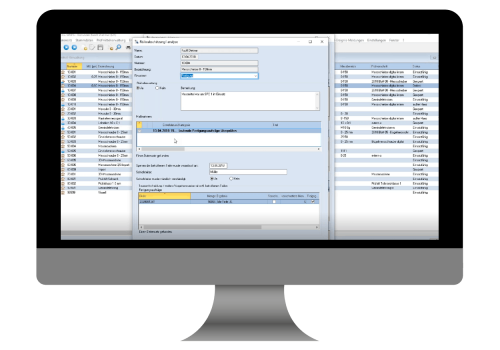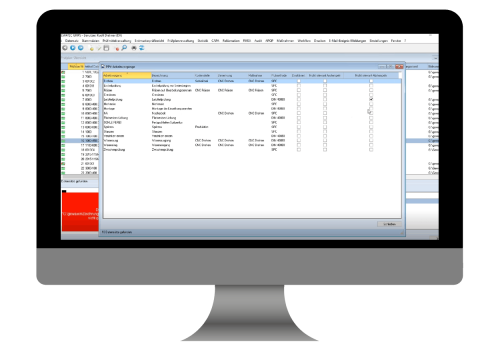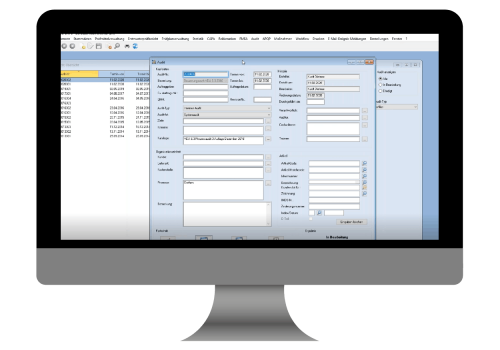
GEWATEC CAQ
GRIPS is a modern quality management system that meetsall the requirements of the automotive supply industry and medical technology.With GRIPS, you always have the quality of your products firmly under control and meet all requirements of the VDA, ISO, QS9000 and TS16949 standards and the FDA. GRIPS is a comprehensive product and process-oriented quality management system for monitoring and controlling your production. The integration of further QM modules enables efficient work in the areas of quality assurance and quality management.
GRIPS is a modern CAQ system that meets all the requirements of the industries of series manufacturers or medical technicians. With GRIPS you have the quality of your products firmly under control. The system fulfills all requirements of the standards VDA, ISO, QS9000 and TS16949 and the FDA. GRIPS is a product and process oriented system for quality management. With our software you monitor and control your production. The integration of further QM modules enables efficient work in the areas of quality assurance and management.
EMP (initial sample inspection report)
With the creation of the initial sample inspection report, the supplier provides proof that its products meet the quality requirements demanded by the customer. The release procedures according to the current standards and specifications, include both product and production process release. The QDX interface enables the digital data exchange of initial sample inspection reports via SupplyOn.
You have the possibility to process the initial sample inspection reports in GRIPS - EMP both as a supplier and as a customer. The processes of the initial sample inspection report creation are constantly adapted to the current standards (VDA 5th & 6th edition, QS9000/ PPAP, IATF 16949).
Initial sample test reports serve as evidence that the delivered products meet the customer's expectations. The release procedures according to the standards and specifications, include both product and production process release. The QDX interface enables digital data exchange from EMP via SupplyOn.
Let both suppliers and customers process the EMP with GRIPS. Create your EMP according to the latest standards ( VDA 5th & 6th edition, QS9000/ PPAP, IATF 16949).
QDX: Data interface
Since 01.09.2014, the company BOSCH has enabled the worldwide electronic processing of the complete initial sample inspection report process with the BOSCH web portal via SupplyOn. In cooperation with BOSCH, we have developed a BOSCH QDX convenience interface since 2012, which you can use to conveniently exchange your initial sample reports.
The entire sampling process is supported with the following functions:
- Import BOSCH EMPB target report
- Export your EMPB actual report
- Import of the BOSCH decision
- Nest sampling
EMP stamping software, the graphically interactive initial sampling
The integrated stamping software supports you in efficiently stamping the drawings as well as automatically generating the inspection characteristics from the drawing. Dimension and tolerance values as well as stamp numbers and feature positions are imported directly from the drawing.
PMV (test equipment management)
Quality assurance requires that the test equipment used is subjected to constant monitoring and calibration. In the GRIPS test equipment management system, all test equipment is recorded in accordance with standards and managed rationally. The constant monitoring of test defects as well as the monitoring of the place of use are integrated in the GRIPS test equipment management as standard. The test equipment can be assigned to specific persons or workstations via the test equipment movement. In addition, connections of different tool cabinets are obligatory. Gauge capability tests according to the different procedures according to MSA can be performed optionally.
PMÜ (test equipment monitoring)
Calibrations can be performed via GRIPS- PMÜ on the basis of generally valid calibration plans according to VDI/ VDE / DGQ 2618 or individually adapted calibration plans. The monitoring history allows the evaluation of test equipment-specific calibration and usage data as well as:
- Status history
- Cost recording and evaluations
PPV test plan management
In the GRIPS inspection plan management, the inspection plans are created with the respective operations and the associated characteristics. Context-related menus guide the user quickly and efficiently through the creation of the inspection plans. The creation of standardized forms, e.g. a control plan, is included in the scope of the standard software. The simple designation as a family inspection plan allows the transfer of all or individual characteristics. The linking of the characteristics in the inspection plans is easily visible. Changes to a family characteristic are transferred to all linked characteristics.
GRIPS inspection planning includes the creation of in-process inspection plans (SPC) as well as incoming and outgoing inspection plans for a wide range of inspection severities and methods. The additional module GIP (graphical interactive inspection planning) supports the operator by visualizing individual measuring steps. One of the unique selling points of the GEWATEC solution is the optional linking of GRIPS and PROVIS. This means, for example, that inspection orders can be generated automatically when production orders are stamped. The nest-related measurement data acquisition especially used in plastic injection molding is also possible in the standard software.
QDE Quality data acquisition
Independent of the inspection equipment connected to the GEWATEC software, the operator is guided through the measuring process via graphically interactive dialogs. The control chart embedded in the measuring process visualizes the process flow of the corresponding characteristic. The characteristic to be inspected and the test equipment to be used are displayed in the open measuring window. Any tolerance violations are marked in color. Remarks and measures can be recorded in the control chart and provide information about process changes and their causes. The integrated nest management navigates the operator through the measurement task for plastic injection molded parts.
Other interesting features include monitoring of inspection intervals and the connection of a wide variety of test equipment (hand-held measuring equipment, measuring machines, etc.).

QSTAT: Quality statistics Continuous distributions:
| Numerical test procedures: |
QST Evaluation, Statistics
In the QST module, measured values recorded in advance can be statistically evaluated in different procedures. The evaluation is performed directly on the corresponding characteristic-related control chart. The calculated key figures provide information about the stability and the process capability of the respective process characteristic. In addition to the process capability analysis (cp/ cpk), the user can also perform machine capability analyses (cm/ cmk). The creation of measurement reports after the incoming and outgoing goods inspection requires only a few clicks. Original value lists can be called up directly from the control chart as well as via individually adapted reports. The evaluation of the measured values in different control charts (Xquer/ S/ R) as well as different distribution types allows a high degree of flexibility in the quality analysis. Short evaluations allow a quick overview of the most important statistical parameters. When evaluating SPC inspection orders, it is possible to recalculate intervention limits on the basis of the process progression and to visualize the processes in different display formats (control charts/histogram/ probability network). The following additional notes are integrated in the standard software:
- cpk/cmk warnings
- Notification of test due date overruns
REKLA Complaint processing
In GEWATEC complaints processing, both external supplier and customer complaints, as well as internal complaints, can be recorded and managed. Customer complaints are processed and documented according to structured standards from the automotive industry, the 8D method or the 5W method. Supplier complaints as well as internal complaints are described in detail in an inspection report and sent to the appropriate person in charge. The printing of blocking cards allows the visual identification of rejected goods. All complaint-related cost types are recorded in the respective complaint, added up and thus form the basis for detailed cost evaluation. The measures created in the complaint are reported and monitored via the central measures management to the respective responsible person. Direct access from the complaint to the stock and production overview of the respective item in GPPS provides a quick overview. Complaints from customers can be forwarded directly to the supplier if necessary. Comprehensive evaluations support the user in analyzing a wide range of criteria.
- Application for one-time construction deviation
- Complaint proposal directly from the measuring station
- Rekla Web Client.
- Ishikawa
- more
FMEA
Both process and product FMEAs can be created knowledge-based via the GEWATEC FMEA module. The possibility to link basic FMEAs with item-specific FMEAS enables a fast and efficient risk assessment and evaluation. Changes can be easily inherited from the basic FMEAs to the item-specific FMEAs. A clearly defined explorer structure guides the user step-by-step through the creation of the FMEA. If necessary, it is possible to switch to the view of the VDA form. Both evaluation by RPN and evaluation by task priority (AIAG VDA 2019) are integrated as standard. In addition to already stored evaluation catalogs, it is also possible to use individually created evaluation catalogs. The transfer of functions directly from the inspection planning as well as the direct data transfer from the complaint processing allow a continuous risk assessment. The blocks of measures derived from this are managed and monitored in the central measures management system.
LBEW (supplier evaluation)
In the GRIPS LBEW, suppliers are evaluated according to product quality, delivery reliability and delivery quantity. The corresponding quality score is calculated on the basis of the selection made. The evaluation can be carried out for specific articles as well as for all articles.
Audit/ -management
GRIPS Audit Management is used to perform internal and external audits. In addition to the standard-specific audit catalogs, it is also possible to create individual catalogs. By selecting the catalogs to be used, the corresponding audit plan is generated for the respective audit. The definition of the standard-specific evaluation criteria allows the execution of standard-compliant audits. Questions that are not 100% fulfilled force the user to formulate appropriate measures. These measures are managed and monitored in the central measures management. The calculation of the evaluation number visualizes the current degree of fulfillment of the audit.
APQP
"Advanced Product Quality Planning" is based on the former QS 9000 and is a tool for project management for product and quality planning.For some time now, APQP has been a central module in the IATF 16949 catalog of requirements in the area of advance quality planning.
The aim is to prevent errors by means of a uniform, product-related
documentation structure/hierarchy, which provides the user with the necessary
transparency about the manufacturing process. This is intended to simplify production control
. All project and product-relevant information and documents
are centrally planned, monitored and managed. All resulting tasks, deadlines and measures are transferred to the GEWATEC measure management for further processing and tracking.
Necessary corrections and adjustments of deadlines and tasks are possible by simply moving the "tasks" in the Gantt chart.
Measuring computer, measuring equipment interface, measuring equipment multiplexer
The GEWATEC IC3015/17 can be transformed into a compact measuring station. Measuring computer and multiplexer for Mitutoyo Digimatic, Opto-RS232 are completely integrated. Measuring probes, for example from Heidenhain or Sylvac, can be connected to the GEWATEC measuring station without any problems. Measuring machines of all common manufacturers can usually be connected to the GEWATEC data acquisition via file sharing.
- 8 x Mitutoyo Digimatic interface integrated .
See also GEWATEC Industrial Computer (IPC)














